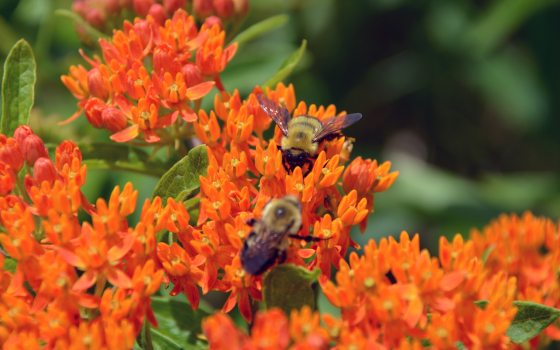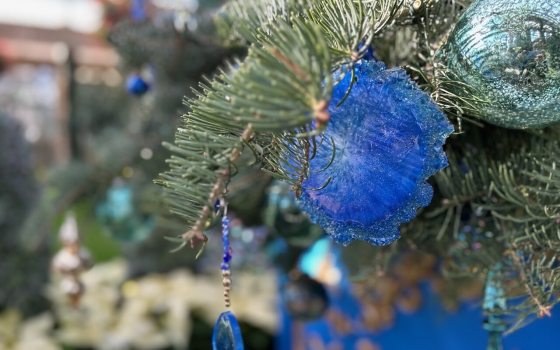While we often think of the landscapes around our homes as self-contained, they’re actually part of a broader landscape mosaic —and each home landscape can make a profound impact on that mosaic and the variety of wildlife (and people!) that rely on it. While the process of creating an ecologically friendly home landscape is multi-faceted and can seem overwhelming, mapping out the goals for your home, truly familiarizing yourself with what’s possible in your landscape, and following realistic maintenance practices can set you up for a successful, ecologically friendly landscape that’s not only beautiful but beneficial.
Getting Started with Goals
First, set your goals for your home landscape. Are you looking to integrate more native plants in your yard? Hoping to create an environment that will have a positive impact on nature and the environment for future generations? Aiming to minimize the input of resources such as water and fertilizer and the output of organic waste? Trying to increase biodiversity? Looking to support birds, pollinators, and other living things by providing food and habitat? Or perhaps all of the above? While those goals may seem lofty, making even small changes in your home landscape can yield big results—but you must set realistic goals based on what’s truly possible on your site.
Setting Expectations
To set realistic expectations for your home landscape, familiarize yourself with your home’s growing conditions, such as sunlight and soil fertility (or soil’s ability to sustain plant growth), moisture, and drainage. These site-specific factors are crucial in selecting the right plant for the right place. Next, consider how much space you have. Even if you’re not working with a lot of space, know that in recent years more compact selections of some native plant species have become available; these selections may be better suited for smaller home garden landscapes. Also, don’t forget to check what’s permitted on your site in the community in which you live.
Making Plant Selections
When it’s time to make plant selections, try not to think like a person—instead, try to think like a bird, bee, butterfly, or so on by viewing your landscape from wildlife’s perspective. When selecting plants, consider if there will be food and habitat for insect pollinators, birds, and other species at any given time of year. When it comes to maximizing habitat, try to utilize vertical layering. Plant in variations of height, using trees, shrubs, and groundcovers together. Sedges, grasses, and ferns can provide valuable cover for many animals.
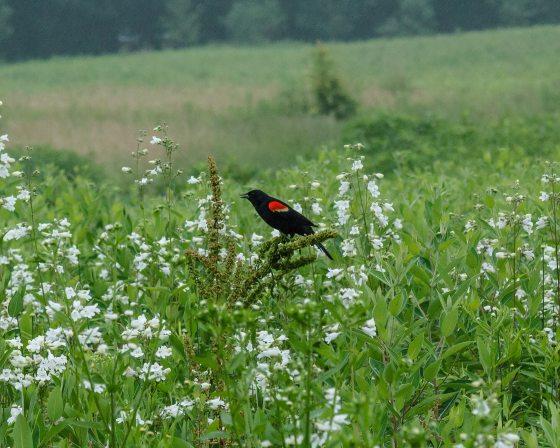
A red-winged blackbird sits amongst beard-tongue (Penstemon digitalis) in the Meadow Garden. Photo by Tom Potterfield.
When it comes to selecting plants as food sources, integrate a variety of flowering species to provide high-quality nectar and pollen sources, ensuring food sources are present continuously throughout as much of the year as possible. In Pennsylvania, some bee species may be active as early as late February. The larval stages of many butterfly and moth species only feed on specific plants, such as monarch butterfly caterpillars which require milkweeds or zebra swallowtail butterfly caterpillar, which feed exclusively on pawpaw trees. Adding such larval host plant species supports these butterflies and moths. To support birds that eat seeds and fruit throughout the year, consider integrating appropriate species as outlined here.
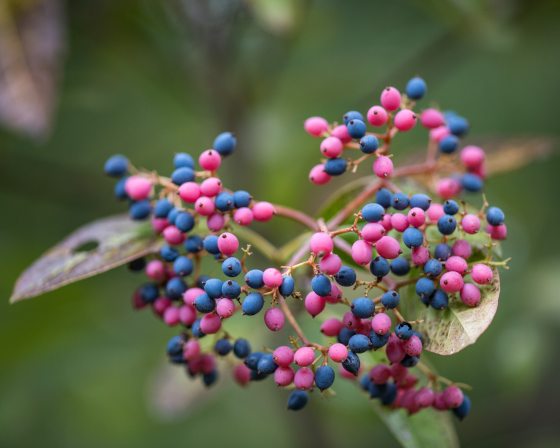
The berries of swamp-haw (Viburnum nudum), which can be seen near our Italian Water Garden, are strikingly beautiful, turning from pink to blue as they ripen in late summer. The fruit are enjoyed by mockingbirds, thrashers, warblers, cardinals, titmice, and chickadees. Photo by Hank Davis.
There are a variety of ornamental plant species native to the mid-Atlantic region that thrive in most average garden soils. When it comes to trees, consider serviceberry (Amelanchier spp.), American holly (Ilex opaca), and white oak (Quercus alba). Serviceberries are one of our earliest flowering trees, lighting up the woodland edge with their showy blooms. They are also one of the first food sources for fruit eating birds, hence their other common name “Juneberry”. The American holly provides evergreen shelter, as well as a food source for fruit eating birds in winter. White oaks can live for hundreds of years and are a food source for the caterpillars of a multitude of butterfly and moth species. In autumn, oak acorns feed mammals such as squirrels, opossums, and deer, as well as many birds including woodpeckers, nuthatches, and blue jays.

Red-bellied woodpecker eating serviceberry (Amelanchier spp.) fruit. Photo by Hank Davis.
Planting the following shrubs can ensure a supply of fruit for birds mid-summer through winter: elderberry (Sambucus canadensis), winterberry holly (Ilex verticillata), and native viburnum species such as arrowwood (Viburnum dentatum), swamp-haw (Viburnum nudum), and black-haw (Viburnum prunifolium). Viburnums and elderberry have the added benefit of showy flowers.
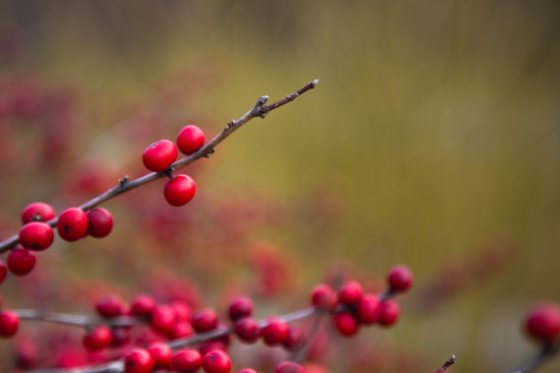
Winterberry holly (Ilex verticillata) can be seen throughout our Gardens and for good reason, as it has beautiful nutrient rich berries, which birds flock to in early winter. Photo by Carol DeGuiseppi.
Good perennials choices for the mid-Atlantic region include butterfly-weed (Asclepias tuberosa), as shown in the first image of this blog post. Beardtongue (Penstemon digitalis), coastal plain Joe-Pye-weed (Eutrochium dubium), mountain-mint (Pycnanthemum flexuosum), and New England aster (Symphyotrichum novae-angliae). All of these species are excellent pollinator plants with showy flowers. Leaving up the hollow stems of mountain-mint and Joe-Pye-weed in the winter, provide nesting sites for native bees.
Maintaining Your Landscape
Ecologically beneficial home landscapes are about more than just the plant species you select; how you maintain your landscape can yield huge ecological benefits. For one, leaving leaf litter and deadwood where possible provides habitat and food sources for wildlife, with the added benefit of insulting plant roots. Dead wood feeds and shelters many living things, including beetles, which in turn feed woodpeckers. Hold off on cutting back the stems of perennials until consistently warm temperatures in spring. That timing can vary by region, but usually occurs when soil temperatures reach out 50 degrees Fahrenheit. Leaving seed heads provides food for overwintering birds. Cutting back stems too soon may disturb butterfly chrysalides attached to them. Beneficial insects, including many native bees, overwinter within hollow stems and may not emerge until the weather warms. If stems need to be removed earlier, carefully cut stems at the base and place them in a protected area outdoors. Don’t feel you need to cover every inch of your landscape with plants or grass. Instead, allow for areas of bare soil. Most of North America’s bees are solitary ground dwelling species, which require bare soil to build nests for the next season’s generation. Patchy lawn areas in shade can be an easy area to allow soil to remain bare.
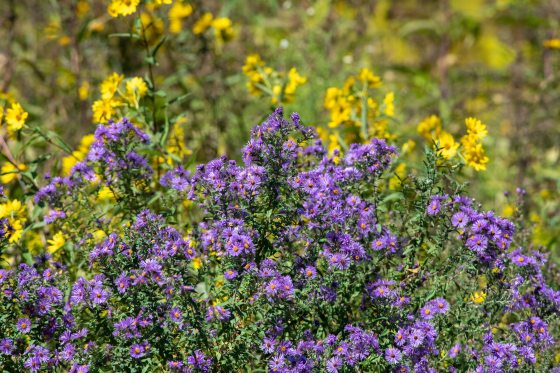
New England aster (Symphyotrichum novae-angliae) is an excellent late season pollinator plant, and its seed heads are a food source for overwintering birds. Photo by Hank Davis.
Communicating Your Intent—and Success!
Ecologically beneficial landscapes can be a bit messy. However, there are ways to communicate that an area is being well cared for; communicating that care may make these landscapes more acceptable, particularly in suburban and urban environments. Incorporating cues that your landscape is being cared for can improve positive perceptions of your landscape and may even inspire your neighbors to follow your example.
Visual cues that a landscape is well cared for include framing ecologically friendly landscape spaces in an intentional way, such as edging with a narrow strip of lawn, utilizing attractive fencing, or pleasantly arranging stones or other natural materials. You can also plant groupings of ornamental native species in the most visible areas, as well as prune native trees and shrubs to create less wild, more controlled appearance. You can also consider the use of interpretive signage, sourced from such organizations as the National Wildlife Federation Certified Wildlife Habitat.
Doing Your Part
From selecting appropriate native plant species to practicing mindful maintenance, creating and maintaining an ecologically friendly home landscape has far-reaching effects. Your home landscape is much more than the space around your home; it’s also a fantastic opportunity to help provide shelter and food for wildlife; increase biodiversity; reduce the use of precious resources; make a positive impact on the environment for future generations; and hopefully inspire your neighbors, and their neighbors, and their neighbors to do the same.
Editor’s Note: Learn more about the many ways in which you can help sustain Pennsylvania’s biodiverse ecosystem—and all that depends on it—as well as how you can use native plants in your own landscape. Longwood is proudly joining gardens across the state in recognizing the second annual Pennsylvania Native Species Day (which falls on May 18) with a variety of walks and talks in our Gardens on May 20. Alongside our expert staff, explore our native ecosystems, learn how to add wildlife-supporting native species to your home garden, discover how to distinguish native plants from invasive species, and delve into what it takes to keep native meadow communities vibrant—all while strolling through the beauty of our Meadow Garden and Peirce’s Woods. Learn more about our Pennsylvania Native Species Day celebration.
Looking to get started on your own native garden? Join Longwood’s Associate Director, Land Stewardship and Ecology Dr. Lea Johnson at The Creamery of Kennett Square on May 18 at 5 pm for Plantology on Tap: The Beauty and Benefits of Native Species. During this fun, fascinating discussion, explore all things native species while enjoying a small bite and cocktail. You’ll leave with top tips for adding native species to your garden, along with a young plant of your own to start your garden. Register now.
